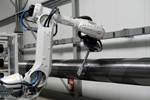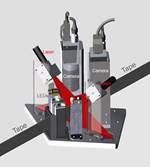Hybrid system by Taniq combines filament winding, AFP
The solution combines two key composites manufacturing processes in a single system, increasing design capabilities and manufacturing efficiency.
Taniq’s filament winding machine with AFP head. Source (All Images) | Taniq
(Rotterdam, Netherlands), specializing in software and robotic winding machines, announces a hybrid solution for composites manufacturing that combines high-speed filament winding with automated fiber placement (AFP).
This hybrid technology enables manufacturers to apply continuous fiber layers at high speed, while also placing targeted reinforcement in high-stress zones. It optimizes material use and product performance. Traditionally two separate processes, Taniq has merged filament winding and AFP into one flexible system in an effort to increase production efficiency and unlock new design possibilities.
At the heart of this development is Taniq’s robotic filament winding machine, extended with an AFP head. The entire process is powered by TaniqWind Pro, a proprietary design and manufacturing software, which supports both winding paths and fiber placement programming in a unified digital workflow.
In addition to improving performance and material efficiency, Taniq reports the hybrid system’s ability to improve strength-to-weight ratios, reinforcing critical areas without overbuilding the part and thus reducing material consumption. Replacing entire high-angle helical filament-wound layers with local reinforcement layers results in faster production cycles, and a simplified software integration ensures a smooth transition from design to analysis to production.
“Taniq has been developing hybrid systems since 2006, combining high-speed filament winding with precise placement of rubber layers and textile tapes.” notes Soren Blomaard, Taniq co-founder. “This new system, combining filament winding with AFP, is a logical next step for us, and we are already exploring integration of more processes.”
Related Content
-
The potential for thermoplastic composite nacelles
Collins Aerospace draws on global team, decades of experience to demonstrate large, curved AFP and welded structures for the next generation of aircraft.
-
Plant tour: Airbus, Illescas, Spain
Airbus’ Illescas facility, featuring highly automated composites processes for the A350 lower wing cover and one-piece Section 19 fuselage barrels, works toward production ramp-ups and next-generation aircraft.
-
Low-cost, efficient CFRP anisogrid lattice structures
CIRA uses patented parallel winding, dry fiber, silicone tooling and resin infusion to cut labor for lightweight, heavily loaded space applications.






